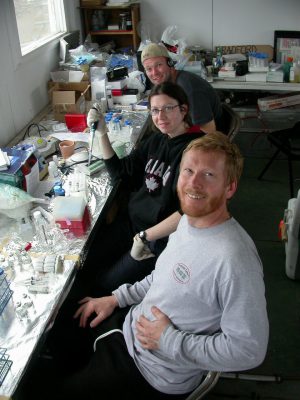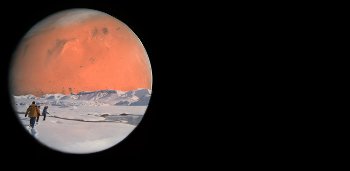By Lucas Wisenthal
If micro-organisms can make it in the high Arctic, they can make it anywhere. Professor Lyle Whyte has spent years digging in seemingly inhospitable tundra, unearthing new insights into microbial life at sub -zero temperatures—on Earth and beyond.

The average annual temperature on Axel Heiberg Island (79° 26’ 0” N), home to the McGill Arctic Research Station (MARS) since 1960, is minus-15 degrees Celsius. To get to the station, you have to fly to Resolute, Nunavut (pop. 229), then switch to a smaller plane, weather permitting, for the remaining 700 kilometres. From an accessibility point of view, MARS is practically, well, Mars. From a microbial point of view, maybe it is.
McGill Department of Natural Resource Sciences professor Lyle Whyte has trekked to MARS once, sometimes twice, each year for the past decade. He’s interested in what microbes may be flourishing in the foreboding permafrost. “Very little is known about the lower limits of life of micro-organisms on this planet,” Whyte says. “Do they grow at sub-zero temperatures? How do they survive?” His work has extraterrestrial implications, too: If Earth’s most unforgiving climes aren’t entirely inhospitable, then what surprises await beneath the “barren” surface of, say, Mars?
In 2008, NASA deployed its Phoenix Mars Lander. For Whyte, the images Phoenix sent back weren’t all that alien. “It looked like the same type of geomorphology, the same type of terrestrial geology or geography that we see right around the McGill station.” In 2003, Whyte and his team discovered that the icy permafrost soils of the high Arctic are actually brimming with microbes. In collaboration with Wayne Pollard (Department of Geography), the team has been analyzing the microbial communities inhabiting cold saline springs around the McGill Station. Their study of a methane seep in thick permafrost uncovered a community of sulphate-breathing microbes thriving in a hypersaline, sub-zero environment. Such wee beasties were previously thought to exist only at the bottom of the ocean. Now, they could conceivably turn up almost anywhere on Earth. Or off.
Organisms that are invisible to the naked eye may not figure into the popular imagination’s idea of “little green men” on Mars, a cold planet with no oxygen and a sur face rendered sterile by radiation, but a few feet below that wasteland, shielded from the outside environment, microscopic life could thrive. “If we couldn’t find microbes in, say, high Arctic permafrost or glaciers or ice sheets, then there’d really be no sense in looking on places like Mars,” Whyte says. “But we are finding these environments that are full of microbes.” He believes that finding such life, even if it’s as simple as bacteria, would have enormous scientific and philosophical implications for humanity, “because it means life is capable of evolving on other worlds even in our solar system.”
At the time of the Phoenix mission, NASA didn’t have the tools to retrieve permafrost samples. Whyte and others from the NSERC-funded Canadian Astrobiology Training Program (of which he’s the principal investigator) are working with the Canadian Space Agency to develop technology to extract samples of the Martian subsurface.
“For me, seeing is believing,” Whyte says. “And it will be great when someone actually brings a sample back and I look at it under an electronic microscope and I can see microbes.” That might happen soon enough. Whyte expects a sample-return mission to be launched in the 2020s. “We’re at the forefront of this great adventure.”
■ Lyle Whyte’s research is funded by the Natural Sciences and Engineering Research Council of Canada, the Canada Foundation for Innovation, Canada Research Chairs, the Polar Continental Shelf Program, Indian and Northern Affairs Canada, the Canadian Space Agency and NASA. Whyte is the Canada Research Chair in Environmental Microbiology and was the Chair of the Astrobiology Discipline Working Group of the Canadian Space Agency from 2007 to 2009.
